Figurative art, perception and hidden images in inverse perspective
Perspective is a mix of geometry and psychology of perception used by artists to construct images of the world. Inverse perspective, or anamorphosis, is a geometric procedure for drawing an image that appears distorted and indecipherable when seen frontally, the image becoming intelligible only from an eccentric viewpoint and/or when reflected by a curved mirror. This procedure involves a dazzling interplay of geometry, figurative art, perspective and psychology of visual perception.
In this paper we present a review of inverse perspective and anamorphosis, starting from Renaissance and Baroque till the present days, when anamorphic techniques are applied to the “3-D street art”, to advertisements and to the psychology of perception, for which “the only reality we experience is brain reality”
Arte figurative, percezione e immagini nascoste nella prospettiva inversa
La prospettiva è una miscela di geometria e psicologia della percezione visiva usata dagli artisti per rappresentare il mondo che ci circonda. La prospettiva inversa, o anamorfosi, è una procedura geometrica per disegnare un’immagine che appare distorta e indecifrabile se guardata frontalmente e che diviene intellegibile solo da un punto di vista eccentrico e/o viene riflessa con uno specchio curvo.
Viene qui presentata una rassegna della prospettiva inversa dal Rinascimento ai giorni nostri, in cui le tecniche anamorfiche sono utilizzate nelle opere d’arte prospettica su strada, nella pubblicità e nella psicologia della percezione, per la quale la sola realtà che cogliamo è quella percepita dal cervello
Paolo Di Lazzaro, Daniele Murra
Historical approach to anamorphosis
The process of deforming a shape, so that it is recognizable only from a privileged position, dates back to the second half of the fifteenth century. The distorted face of a child in the Codex Atlanticus of Leonardo da Vinci, dating from the 1480s, is the earliest known definitive example of anamorphosis. In the Codex A Leonardo illustrates a technique to construct an anamorphosis making use of a hole through which a light source projects the shadow of the object to be drawn on a surface [1]. Leonardo defines this technique "accidental perspective" as opposed to the "natural perspective", because distant objects are drawn larger than near objects, contrary to what we observe in reality.
Actually, a simple anamorphosis had already been painted in 1472 by Piero della Francesca in his Pala di Brera. In this masterpiece, the suspended egg that appears on the background turns into a perfect sphere when viewed at a grazing incidence from the bottom, and Piero della Francesca describes the artifice in De prospectiva pingendi [2]. A more sophisticated anamorphosis was drawn by Hans Holbein the Young in the painting The Ambassadors (1533), with a skull stretched anamorphically, which is unrecognizable when observed in front, but perfectly visible when viewed from the left-low corner of the paint [3].
Many treatises on perspective were published between the end of 1500 and 1700, which discuss anamorphic techniques. Among them, the most important is La perspective curieuse, ou magie artificielle… by Jean François Nicéron (1638) [4]. The work of Nicéron is the first detailed analysis of geometric methods for creating both perspective- and mirror-anamorphoses, even if the word "anamorphosis" will appear later, in the book of 1646, Ars Magna lucis et umbrae by Athanasius Kircher [5], as a neologism from the Greek αναμόρφωσις, which can be translated as “form again a figure”.
The inverse perspective
With the help of Nicéron, let us illustrate an example to understand how to design an anamorphic drawing by perspective deformation. Figure 1 shows the face of a bearded man, divided into a grid of 36 square boxes. If we deform the grid so that the horizontal lines are converging towards the point X, and the vertical lines are drawn as a function of the position of the point Y, we obtain the shape at the bottom of Fig. 1, divided in 36 trapezoids.
The deformation of the face follows a precise rule: the drawing within each trapezium begins and ends at the same point of the corresponding square box of the original sketch. This rule allows to see the original drawing perfectly recomposed if one observes the anamorphosis from the perspective point that is located above the point X, at an elevation equal to the length of the segment XY in Fig. 1.
Clearly, the smaller the boxes, the more accurate the rendering of the anamorphic drawing. In addition, the longer the length e-f of Fig. 1 and the smaller the distance XY, the stronger will be the deforming effect. Finally, the farther the point X, the larger the zone available to look at the anamorphic drawing formed again in the correct proportions.
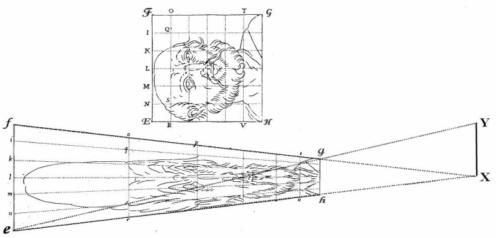
FIGURE 1
Design of an anamorphosis by perspective deformation. Revised by the authors from the original drawing in [4]
In the central-perspective drawing, the canvas is placed between the painter and the subject to be represented. Consequently, the rays which travel from the subject to the eyes of the painter meet the canvas in their ideal path. On the contrary, to make an anamorphosis the rays are projected from the painter eye’s to the subject and from this they are ideally prolonged to meet the surface on which the subject will be drawn. It is, therefore, a sort of "inverse perspective" as mentioned in a chapter of the treatise [6]: Modo di fare la prospettiva inversa che paia vera, essendo veduta per un solo forame (How to create the inverse perspective that seems true, as seen by a single foramen). The need of the "single foramen" is because the anamorphosis is best appreciated when viewed with one eye only (so as to lose the perception of depth given by the binocular vision) and from a designed point, using, e. g., the hole proposed by Leonardo as a ploy to create anamorphic drawings [1].
By the way, the concept of inverse perspective may give an alternative explanation of the origin of the word "anamorphosis". In fact, the Greek prefix "ana", among other meanings, can be translated as "against", "inversion". The meaning of anamorphosis could therefore be “making a shape to the contrary", that is, drawing according to a technique that reverses the rule of the natural perspective.
An outstanding example of anamorphic art was painted in 1646 by Emmanuel Maignan, a theologian of the Order of Minims like Nicéron, who wrote an important treatise on gnomonics [7]. It is in the convent of Trinità dei Monti, nearby Piazza di Spagna, downtown Rome. Along a corridor, a wall is painted in shades of gray, with some yellowish tinge, which reproduces a coastal landscape, a gulf crossed by a small sailing boat (see Fig. 2).
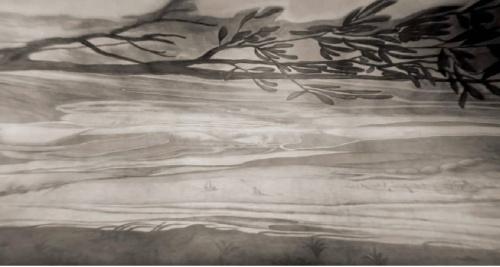
FIGURE 2
Central view of the fresco of Maignan. Photo by the authors
Looking carefully, we see small houses and roads against the backdrop of terraced hills and oddly shaped clouds. We also recognize tufts of grass in the foreground. All the details (boats, houses, grass) are represented in an elementary way, but the overall set of lines and soft curves has its own stylistic consistency [8]. After a door, beyond which the fresco continues with an olive tree, we turn behind: all the lines that made up the coastal landscape in the fresco reassemble in the figure of St. Francis of Paola, kneeled and praying, see Fig. 3. The houses and boats disappear, overwhelmed by the shape of the saint.
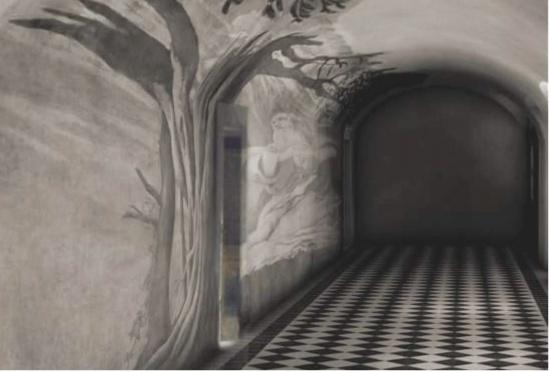
FIGURE 3
The fresco of Maignan, as seen from the perspective viewpoint. The horizontal lines visible in Fig. 2 are recomposed forming the portrait of S. Francesco di Paola kneeled and praying
The view of the Maignan painting from the perspective point gives the illusion that the image of the Saint leans out of the wall. The photo in Fig. 3 returns only partially this illusion, because only the direct observation of the fresco allows the eye to adapt the vision with small movements around the point of perspective, thus achieving an effect that, in the words of Leonardo [1] non ti potrà mai persuadere che detta figura non sia dispiccata dal muro (no one will ever persuade you that this figure is not lifted from the wall).
The illusion of a pattern leaning out of the wall is typical of anamorphic drawings. This is a consequence of the apparatus used to paint anamorphic frescos, and Fig. 4 shows the one exploited by Maignan.
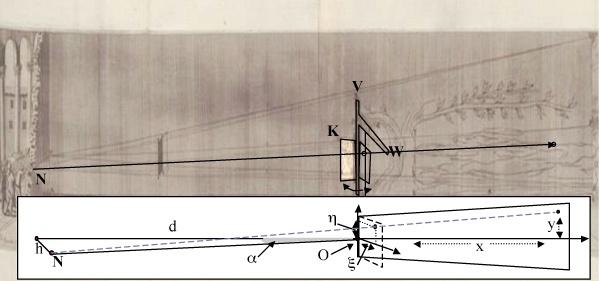
FIGURE 4
Diagram of the procedure followed by Maignan to draw the anamorphosis of S. Francis of Paola. Revised by the authors from the original sketch in [7]. The inset below shows the reference system we used to deduce the equations (1) mapping a drawing into its perspective anamorphosis
The portrait of the saint is placed on the board LK, which is hinged on the vertical axis V leaning on the wall and can rotate by 90°. Along a plumb line hanging on the bar W perpendicular to the wall, a small sphere can be locked at the desired height in order to identify the reference points of the portrait. From N a wire is pulled passing in close proximity to the sphere to reach the wall, where the corresponding point of the portrait is reported. Once we mark all points on the wall, joining them we get the anamorphic figure. In this way, the observer placed in N will perceive a drawing that leans out of the wall, just as if there was a canvas perpendicular to the wall. This is because, unlike classical perspective where the canvas is like a window through which we see the subject, in the anamorphosis the window is reconstructed by our mind placing it where the painter had put the drawing before projecting it on the wall, as shown in Fig. 4.
In addition to the geometrical procedure by Nicéron illustrated in Fig. 1, we can obtain the analytical equations which map points (ξ, η) of a drawing to points (x, y) on the anamorphic plane. With reference to Fig. 4 (where the origin of coordinates of both the drawing and its anamorphosis is located at the letter ‘O’), simple calculations give the coordinates of the anamorphic deformation as

where h is the distance of the observer N from the wall, α is the elevation angle of the observer (that is, the angle between the wall and the horizontal line joining the observer to the vertical axis V), d is the distance between the original drawing and the projection of N on the wall, η is the coordinate of the vertical displacement of the point on the original drawing with respect to the height of the observer in N, ξ is the other coordinate of the same point, perpendicular to η.
The deformation effect is proportional to the ratio R=x/ξ, that is, to the term:
![]()
From Eq.(2), to obtain a very large deformation α should be very small (if tan(α)→0, then R→ ∞) or h≥ξ (if (h-ξ) →∞, then R→∞). On the contrary, when α→π/2, the line of sight is perpendicular to the wall, tan(α)→∞ and all the x coordinates of the anamorphic image go to zero, thus collapsing the anamorphosis.
Anamorphosis by reflection
In addition to anamorphoses by perspective deformation, it is possible to create catoptric anamorphoses, so as to reconstruct the original image by observing the anamorphosis reflected by a suitable mirror [9]. Even in this case, Nicéron was the first to provide geometric rules to implement cylindrical, conical and pyramidal anamorphic drawings [4]. In the case of conical anamorphosis, the original picture is inside a circle divided into 36 sectors by 3 diameters and 6 concentric circles, as shown in Fig. 5 (the picture is not shown in the sketch). These sectors are reported at the basis of a cone (letters H,I,K,L,M in Fig. 5) and from each point which delimits sectors, a line is drawn to the observer’s point E. The intersection of each line with the cone gives the point of reflection, from which it is easy to find the corresponding point on the anamorphic plane where the cone is placed. For example, in Fig. 5 the point M at the basis of the cone corresponds to point O in the plane, K to Q, H to S, and so on. In this way, each sector of the original circle is anamorphically deformed in sectors of annuli having different radii.
The original picture becomes visible when observing from the point E the anamorphic drawing reflected by a conical mirror put in the central half-circle of Fig. 5. Due to the shape of the mirror, the anamorphic drawing by conical deformation looks scrambled and upside down (see two examples in Figs. 6 and 7).
In mathematical terms, the conical anamorphosis is a mapping of concentric rings of radius r transformed to rings of radius r’ when reflected off the conical surface. The exact relation between r’ and r is given by

where h is the height of the cone, ρ is the base radius of the cone, A=r/(d+h) where d is the distance between the observer and the cone apex, and B=(h²-ρ²)/( ρh). Due to geometrical constraints, r’>ρ>r and h>ρ.
When the observer (point E in Fig. 5) is at a distance d>>h, (a not unreasonable assumption in practice) from Eq. (3) A→0, and the relation between r and r’ is approximated by the simple formula
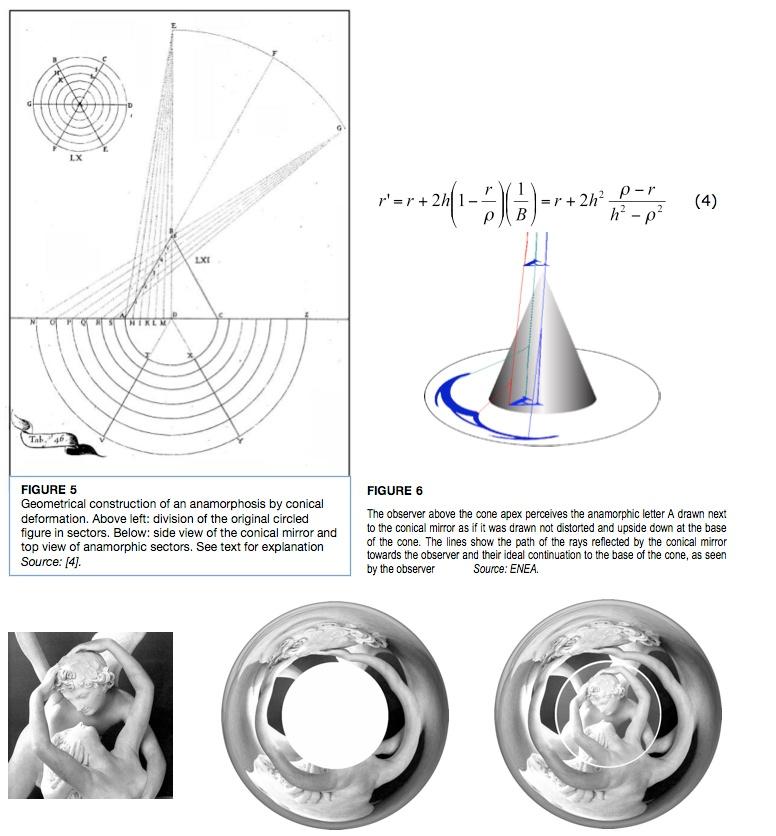
FIGURE 7
Left: Detail of Canova’s sculpture Psyche Revived by Cupid's Kiss. Middle: anamorphosis by conical deformation of the image on the left. Right: after placing the conical mirror in the middle, the observer above the apex of the mirror perceives the undistorted image as if it was at the base of the cone
Source: ENEA
In the anamorphosis of Fig. 7, the parts far from the centre of the original image (e.g., hair of Psyche and Cupid, arms of Psyche) are upside down but still recognizable, whereas the parts close to the centre (e.g., nose, mouth and chin of both Cupid and Psyche) are spread along the whole circumference of the anamorphic drawing, making them impossible to decipher without the conical mirror.
The anamorphosis by cylindrical deformation follows a similar procedure but a different mapping, so that the anamorphic figure is less deformed and easier to decipher than the conical one. An example is shown in Fig. 8, where a metallic cup acts as a cylindrical mirror.

FIGURE 8
Modern example of cylindrical anamorphosis. The anamorphic writing on the dish "tea" becomes readable when the observer looks at its reflection by the cylindrical metal cup
Source: http://richardjohn.com.br/links/figurahumana/exercicios/anamorfose.html
Although anamorphosis may appear a mere play for the purpose of eliciting a pleasant surprise, the scientist, artist and politician Pietro Accolti (XVII century) reveals that anamorphic techniques were used to code secret writings and sketches [10]. In a letter, a sentence or a drawing was camouflaged by anamorphosis, which became readable only when looking at grazing incidence its reflection by a mirror placed perpendicular to the paper, thus revealing the true content of the letter.
Anamorphoses today
Nowadays the most common examples of anamorphosis are advertisements on soccer fields and around the motor-racing tracks in Formula 1. These are banners drawn distorted on the ground, that, when framed by the camera (seen by a single foramen) which broadcasts the event, appear on television screens as classic billboards, standing up and well-proportioned.
However, the most stunning examples of modern anamorphic art are made by artists “on the road”, who draw anamorphoses on squares, streets and buildings. The dimensions of these artworks are impressive, up to several hundreds of square meters, and the perspective effect is amazing (see the example of Figs. 9 and 10).
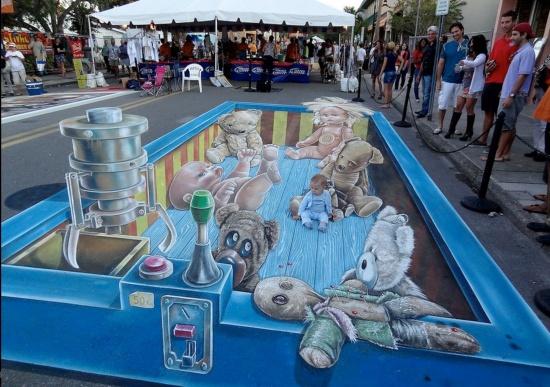
FIGURE 9
"Grabber machine", anamorphosis on the road made by Leon Keer during the Chalk Festival in Sarasota, (USA), November 2012. The spectators in the background reveal the huge size of the drawing. Note the powerful 3D illusion of the figures “sitting” near the (real) child.
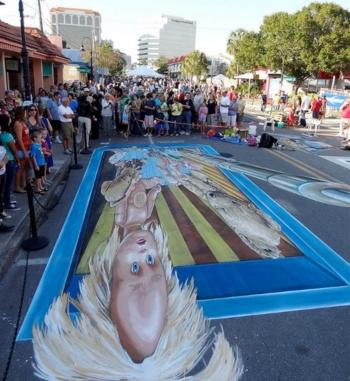
FIGURE 10
The same drawing of Fig. 9 from the position opposite to the perspective point. Here we can appreciate the anamorphic distortion of the drawing that is astonishing for its size and development. At first glance, it is hard to believe that this photo is a different view of Fig. 9
An original form of anamorphic art is the "ephemeral garden" by François Abélanet. Apparently, it is a normal garden extending for fifteen hundred square meters, with a rolling terrain and several trees and paths. When observed from the perspective point of view, placed two meters above the level of the square, the garden is transformed and recomposed into a green globe crossed by thin vertical and horizontal lines representing meridians and parallels (see Fig. 11). This beautiful work of anamorphic art can be seen in the video [11].

FIGURE 11
The “ephemeral garden” featured in front of Paris’ city hall, where it was exposed from June 24 to July 17, 2011. Left: the garden from the square. Right: the same garden from the perspective point, placed over two meters above the ground. The size of the person placed near the "north pole" of the "globe" reveals the true size of the garden. Or does it reinforce the idea that we are looking at a globe?
Source: [11]
Art and advertisements are not the only applications of modern anamorphoses. As an example, psychology uses anamorphosis to study how our visual perception is conditioned by shapes and past experience. A famous “case study” is the distorted room designed by Adelbert Ames [12]. It is a room having the left wall longer and higher than the right wall, or vice-versa. Consequently, the wall opposite to the observer is an oblique trapezoid, and the ceiling, or the floor (or both) are at an incline. The windows on the walls are also trapezoids (see Fig. 12a). If we look at the room through a peephole, we lose the binocular vision that gives us the perception of depth. When the peephole is positioned in the perspective point, the room appears normal in shape (see Fig. 12b).
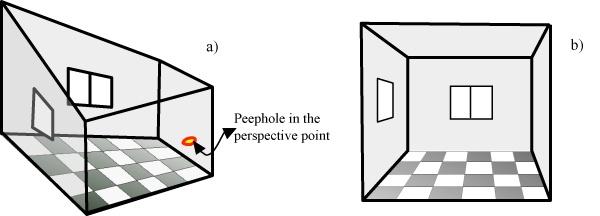
FIGURE 12
a) The distorted room of Ames. b) The same room appears normal in shape if observed through the peephole positioned in the perspective point: it is a three-dimensional anamorphosis. Source: ENEA
Two persons of identical heights, when standing in each corner of the wall opposite to the observer, appear of clearly different height, because they are at different distances from the observer and their heads are at a different distance from the ceiling (see Fig. 13).
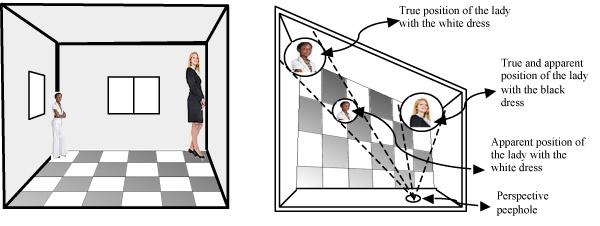
FIGURE 13
Left: two persons of identical heights appear very different when standing at the corners of the wall opposite to the observer in the Ames room of Fig. 12. On the right: top view of the Ames room: the perspective explains why persons appear different. The concept of inverse perspective described in §2 applies to the lady with the white dress
Source: ENEA
The observer perceives an ambiguous situation, which allows two possible interpretations. The feeling that the room "must" be regular dominates the perception, and our brain prefers to admit that we are observing a dwarf and a giant rather than two normal persons in a deformed room. Amazingly, when people shrink or grow as they move from one corner to another, the evident contradiction does not influence our assumption that the room is normal.
One can therefore understand how the anamorphosis of the Ames room has provided important information on the psychology of visual perception, e.g., the priority given to the topologically invariant characteristics (we are sure to see a room normal in shape) with respect to Euclidean properties (we don’t attribute the change of people heights to the change of their distance from us), the importance of the phenomenon known as the "constancy of dimensions", and how our mind tends to see what it expects or wants to see.
The construction of the Ames room requires a careful design, because all five trapezoidal walls are inclined, none is parallel or perpendicular to the others, and finally both shape and position of doors, windows, frames and objects in the room play an important role in the perception of the three-dimensional anamorphosis. The authors of this paper have designed a distorted room which was presented in the RAI program Geo Science that can be seen in the video [13], and have also carried out various perspective anamorphoses presented in RAI broadcasts; some of them can be seen in the video [14].
Over the last few decades the term "anamorphosis" has been related to several types of deformations [9], e.g., coordinate transformations and projections used in cartography, or the so-called anamorphic lenses used in the movie-cameras that compress the images laterally in the standard 35-mm films and re-expand them during the projection in Cinemascope, or horizontal markings on roadways, or the transformation of functions by change of variables in nomography, or the transformation of biological organisms into more complex forms, and even caricatures. In our opinion these are arbitrary extrapolations of the concept of anamorphosis. In agreement with Nicéron [4], the anamorphosis is a deformation that is corrected by the perspective or by mirror reflection when looking at the object from a particular position from which the figure is formed again. As in the examples above there are not perspective points, they are not anamorphoses in the original sense of the term.
Concluding remarks
Anamorphosis is a small but fascinating chapter of perspective, a mix of psychology of perception and geometry used by artists to draw images that appear indecipherable when seen frontally and become intelligible only from an eccentric viewpoint, and/or when reflected by a curved mirror. The period from the Renaissance to the Baroque was characterized by detailed studies of the inverse perspective, which allowed artists to challenge the pleasure of the illusion, of the weird perspective, of the search of surprise able to generate the wonder of observers and to code secret writings and sketches [8, 10]. Most of large-scale anamorphoses and trompe l’oeil were made between 1500 and 1700 and include the apse of the church of S. Maria presso San Satiro in Milan by Donato Bramante, the perspective scenes of the Teatro Olimpico in Vicenza by Vincenzo Scamozzi, the false dome and ceiling of the church of S. Ignazio in Rome by Andrea Pozzo, the gallery of Palazzo Spada in Rome by Francesco Borromini.
Nowadays, anamorphic techniques are successfully used by artists of the “street art”, like Kurt Wenner, Julian Beever, Manfred Stader, Edgar Muller, Eduardo Relero, François Abélanet and Leon Keer. A web-search of their names leads to photos and videos of amazing anamorphic artworks having a great visual impact.
The study of the perception of three-dimensional anamorphoses like the room of Ames has provided important information on various aspects of the psychology of human perception, paving the way forward for the most recent developments in neuroesthetics. According to the neurobiologist Prof. Semir Zeki [15], Because all art obeys the laws of the visual brain, it is not uncommon for art to reveal these laws to us, often surprising us with the visually unexpected.
References
[1] Leonardo da Vinci, Codex A (2172) of Istituto di Francia (circa 1515), fol 42v.
[2] Piero della Francesca, “De prospectiva pingendi” (circa 1475) fol 98v-99r.
[3] Painting “The ambassadors”: http://www.nationalgallery.org.uk/paintings/hans-holbein-the-younger-the-ambassadors
[4] Jean François Nicéron, “La perspective curieuse, ou magie artificielle des effets merveilleux de l'optique par la vision directe…” (Paris, 1638).
[5] Athanasius Kircher, “Ars Magna lucis et umbrae” (Roma, 1646) Liber II Pars II, Propositio VIII, pp. 183-184.
[6] Giovanni Paolo Lomazzo, “Trattato dell’arte della pittura, scultura ed architettura” (Milano, 1585 Sesto Libro, cap. XIX, pp. 335-336.
[7] Emmanuel Maignan, “Perspectiva horaria, sive de horographia gnomonica” (Roma, 1648).
[8] Paolo Di Lazzaro and Daniele Murra, “L’anamorfosi tra arte, percezione visiva e prospettive bizzarre” Technical Report ENEA RT/5/2013.
[9] Martin Gardner, "Anamorphic art”, Scientific American, 232, 110-116 (January 1975).
[10] Pietro Accolti, “Lo inganno degli occhi” (Firenze, 1625) cap. XXXVI p. 48.
[11] The ephemeral garden of Abélanet: www.youtube.com/watch?v=zbislrtfrgs
[12] Biography of Prof. Ames: http://en.wikipedia.org/wiki/Adelbert_Ames,_Jr.
[13] The Ames room made by authors and presented in the RAI TV science broadcast “Geo Scienza”: http://www.rai.tv/dl/RaiTV/programmi/media/ContentItem-75d28411-7121-4af8-a302-39d71ca63eef.html#p= and on www.tvrit.it/enea/20120228-RAI_3-COSE_DELLALTRO_GEO_1555-174503505a.ASF
[14] Various anamorphic objects made by authors and presented in the RAI TV science broadcast “Geo Scienza”: http://www.rai.tv/dl/RaiTV/programmi/media/ContentItem-9013d9a5-7baa-4499-a34f-b9277709a6cd.html#p= and on http://www.tvrit.it/enea/20121004-RAI_3-GEO_SCIENZA_1705-185917236a.ASF
[15] The neuro-aesthetics: http://www.neuroesthetics.org/statement-on-neuroesthetics.php
Image credits
Figures 1 and 5: reference [4].
Figure 4: reference [7], Liber Tertius, Propositio LXXVII, p. 438.
Figure 8: http://richardjohn.com.br/links/figurahumana/exercicios/anamorfose.html
Figures 9 and 10: http://www.streetpainting3d.com/en
Figure 11: reference [11].
Paolo Di Lazzaro, Daniele Murra - ENEA, Technical Unit for Radiation Application Development

